![]()
![]()
Their fear of items being stolen, or not being returned, was considered preposterous. When the Honorable Adviser and his excellency the Charge d’Affaires had themselves, guaranteed the safety of Bangladesh’s most prized artefacts, surely the protesters could have no reason to oppose this arrangement. News of the missing crate, and the priceless statues it contained, had been suppressed, but the information leaked out. Could the guarantors please explain?
Mr. Jean Romnicianu, Charges d’Affaires, Ambassade de France ? Dacca, met with Bangladeshi journalists at the French Embassy in the first week of December 2007. In response to questions about the possibility of goods being damaged, stolen, or not being returned, he stated emphatically, “What I am saying is that for at least 30 years, it has never, not once, happened within the framework of an international exhibition. This is an international exhibition with a signed agreement between governments, there is no scope whatsoever of that kind of thing.” “We will take care of the artefacts, until they are returned to the museum. All the insurance and everything is what is called nail to nail,” elaborating that it implied protection from the moment the artefacts left their original position in the museum, to the time it was returned to their original position.
guimet-nail-to-nail.mp3
Today we hear him on television saying “The responsibility of the French Goverment begins from the point where the items are in French cargo.”
“We are not going to put the artefacts at risk by unpacking them,” was also something the Charge d’Affaires had said that day. Today (Dec 24th 2007), the BBC quoted that the remaining crates had all been checked at the airport. So airport officials who have no knowledge of archaeology are permitted to open the crates, while neither members of the expert committee nor the people who are legally required to inspect the artefacts, are allowed to do so. These officials had also signed documents stating they had verified the contents of the crates, which they had obviously not been allowed to do, even though it made the documents presented, technically false.
“The Museee Guimet and our authorities in France have worked rather hard, I must say, even though it resulted in one mistake, in keeping all the controversies outside of the French papers, of the European papers,” the Charge d’Affaires had also said that day. So the cover up was taking place at both the Bangladeshi and the French end. Presumably it continues.
french-statement-on-media-blockage.mp3
(Audio recordings of these statements are available and will be uploaded as soon as they have been digitised)
——–
 The plane that was meant to have taken the artefacts to Paris. ? Munir uz Zaman/DrikNews
The plane that was meant to have taken the artefacts to Paris. ? Munir uz Zaman/DrikNews
 From Pukur Churi (stealing a pond) to Pukur Pare Churi (stealing by a pond). Search party looking for stolen artefacts by the pond at Zia International Airport. ? Munir uz Zaman/DrikNews
From Pukur Churi (stealing a pond) to Pukur Pare Churi (stealing by a pond). Search party looking for stolen artefacts by the pond at Zia International Airport. ? Munir uz Zaman/DrikNews
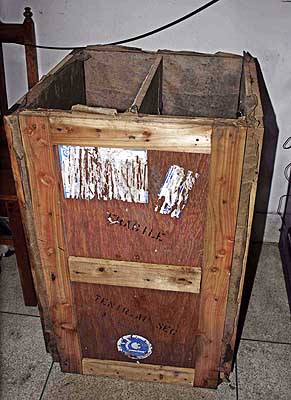 The empty crate. We had been told these were special crates that could not be opened, as they were very special. A 300 year old French company had been especially commissioned to pack the crates. The government and the French embassy decided to show improper documents rather than risk opening these special crates for proper inspection and documentation. Looks like a pretty ordinary crate to me. ? Munir uz Zaman/DrikNews
The empty crate. We had been told these were special crates that could not be opened, as they were very special. A 300 year old French company had been especially commissioned to pack the crates. The government and the French embassy decided to show improper documents rather than risk opening these special crates for proper inspection and documentation. Looks like a pretty ordinary crate to me. ? Munir uz Zaman/DrikNews
 This was a story the state owned BTV had chosen to completely ignore. The rest of the media however, despite government efforts continued to report this important story. Despite the widespread protests and the media attention, the shipment was to go ahead. Both the Cultural Adviser and the French Charge d’Affaires, emphatically promised there was no question of items going missing or not being returned. ? Munir uz Zaman/DrikNews
This was a story the state owned BTV had chosen to completely ignore. The rest of the media however, despite government efforts continued to report this important story. Despite the widespread protests and the media attention, the shipment was to go ahead. Both the Cultural Adviser and the French Charge d’Affaires, emphatically promised there was no question of items going missing or not being returned. ? Munir uz Zaman/DrikNews
b035.mp3 Interview of police officer after discovery of crate (Bangla). Munir uz Zaman/DrikNews
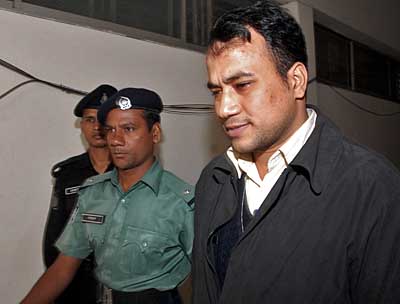 One of the arrested security officers. What of the big fish that masterminded this theft? Or the people who authorised this shipment despite the proven irregularities? ? Munir uz Zaman/DrikNews
One of the arrested security officers. What of the big fish that masterminded this theft? Or the people who authorised this shipment despite the proven irregularities? ? Munir uz Zaman/DrikNews
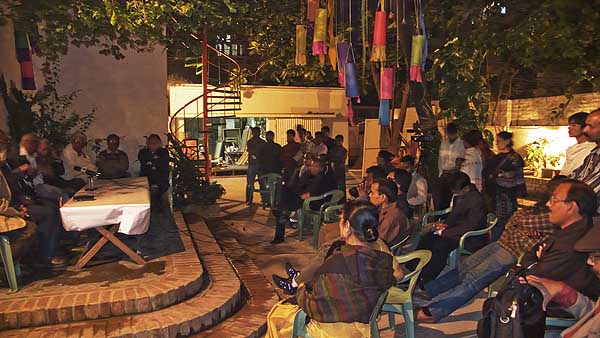 Press conference at Chitrak Gallery, where the incident has been called the most major cultural disaster of the century. ? Shahidul Alam/Drik/Majority World
Press conference at Chitrak Gallery, where the incident has been called the most major cultural disaster of the century. ? Shahidul Alam/Drik/Majority World
——–
It was the letter from Shanika, the girl I had found during the Tsunami in Sri Lanka, that reminded me of how we had forgotten all the other things that were going on. It was now Boxing Day. The Day the Tsunami had struck. Bodies are still being discovered after the Sidr cyclone. Demand for the trial of war criminals has moved off the headlines. Bodies of workers remain buried in the Rangs building rubble. It reminds me of how classed our struggles are. While we had united in protest when our archaeological heritage was being threatened, no such protest had taken place in solidarity with the workers.
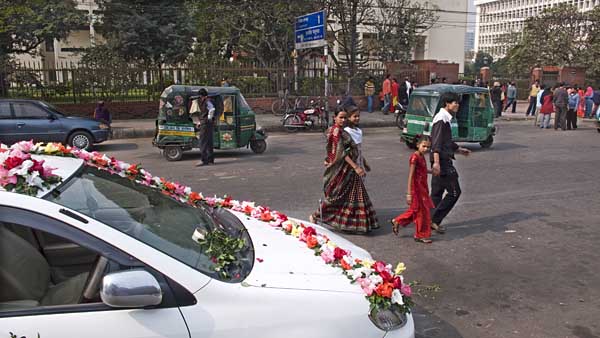 It was Christmas day, and it is the wedding season in Bangladesh. People had gathered outside the musuem, as word had spread that the remaining artefacts were being returned. It was a very different mood, and the local flower shop was using the wide road to decorate a wedding car. ? Shahidul Alam/Drik/Majority World
It was Christmas day, and it is the wedding season in Bangladesh. People had gathered outside the musuem, as word had spread that the remaining artefacts were being returned. It was a very different mood, and the local flower shop was using the wide road to decorate a wedding car. ? Shahidul Alam/Drik/Majority World
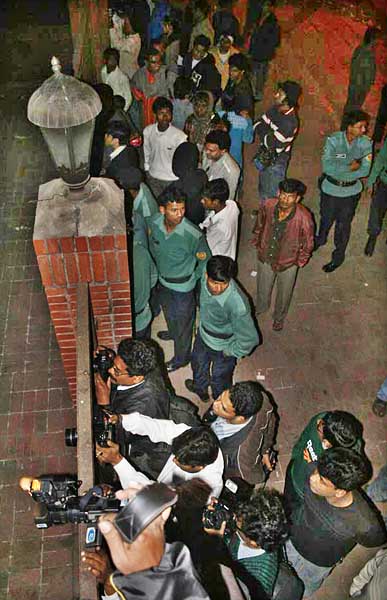 Media professionals outside museum gate watching the return of remaining 12 crates. ? Munir uz Zaman/DrikNews
Media professionals outside museum gate watching the return of remaining 12 crates. ? Munir uz Zaman/DrikNews
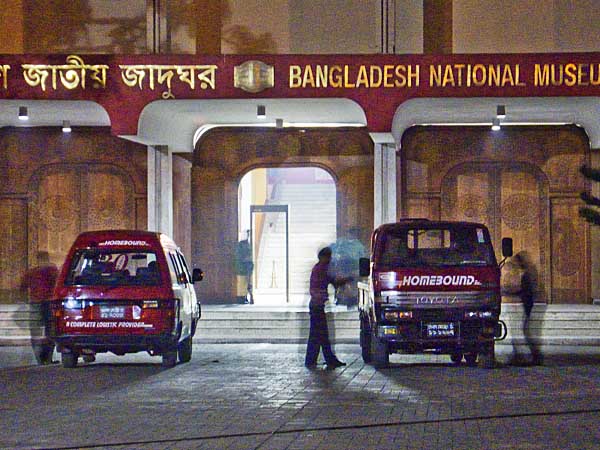 Homebound heading home. The crates are now back in the museum. The demand for reinstating them in their original location continues. ? Shahidul Alam/Drik/Majority World
Homebound heading home. The crates are now back in the museum. The demand for reinstating them in their original location continues. ? Shahidul Alam/Drik/Majority World
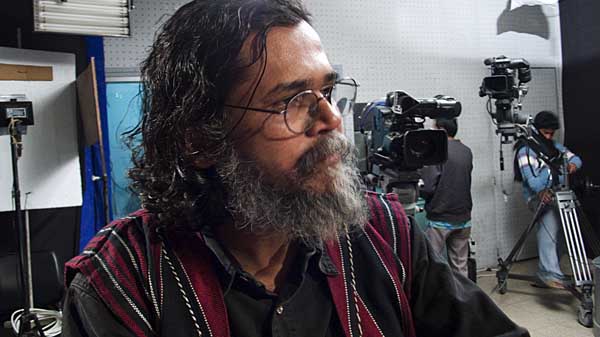 It was the vigilance of Nisar Hossain (teacher at the college of fine arts, affectionately dubbed, ‘Sector Commander’ by fellow campaigners) and his friends that led to many of the irregularities being unearthed. Nisar being interviewed on the ATN channel. ? Shahidul Alam/Drik/Majority World
It was the vigilance of Nisar Hossain (teacher at the college of fine arts, affectionately dubbed, ‘Sector Commander’ by fellow campaigners) and his friends that led to many of the irregularities being unearthed. Nisar being interviewed on the ATN channel. ? Shahidul Alam/Drik/Majority World
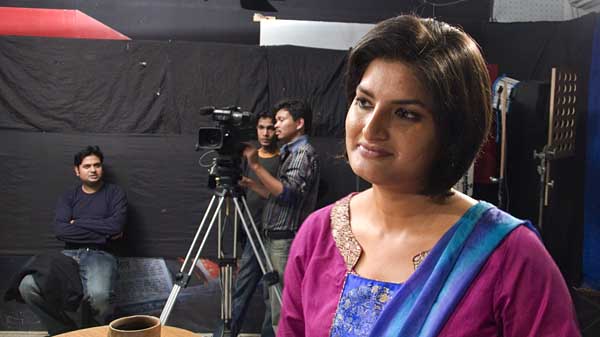 The media played an important role in keeping the issue in the public eye. Munni Saha interviewing Nisar Hossain for a programme in the ATN channel. The discussions included a clear condemnation of the French Charge d’Affaires’ statement blaming the protestors for the theft. The programme will air at 11:00 am Dhaka time on the 26th December 2007. ? Shahidul Alam/Drik/Majority World
The media played an important role in keeping the issue in the public eye. Munni Saha interviewing Nisar Hossain for a programme in the ATN channel. The discussions included a clear condemnation of the French Charge d’Affaires’ statement blaming the protestors for the theft. The programme will air at 11:00 am Dhaka time on the 26th December 2007. ? Shahidul Alam/Drik/Majority World
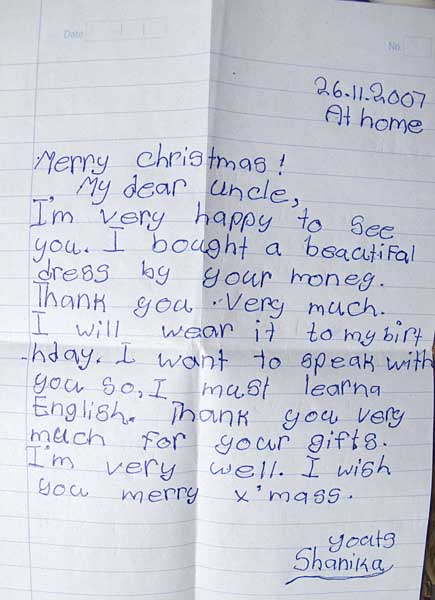 Letter from Shanika, received earlier in the month.
Letter from Shanika, received earlier in the month.
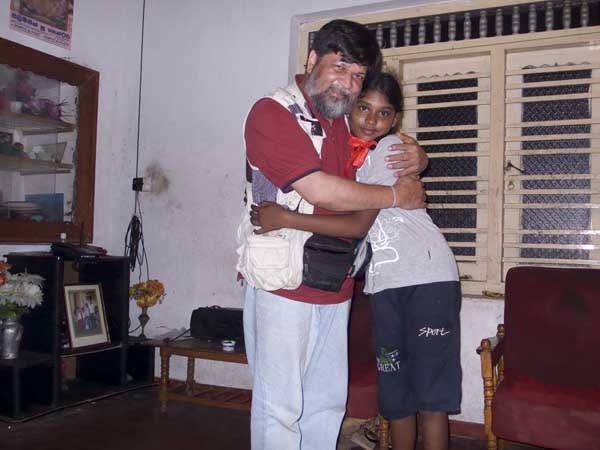 During an assignment for Help The Aged in Sri Lanka last month, I had sneaked a visit to Totagumuwa, in Hikkaduwa to see Shanika. The Tsunami had taken away her mother and her three sisters (including her twin sister). Photo: ? Priantha (Shanika’s dad).
During an assignment for Help The Aged in Sri Lanka last month, I had sneaked a visit to Totagumuwa, in Hikkaduwa to see Shanika. The Tsunami had taken away her mother and her three sisters (including her twin sister). Photo: ? Priantha (Shanika’s dad).
——-
27th December 2007
Sylvie Rebbot, the picture editor of Geo Magazine in France, just sent me this press release last night. It was issued yesterday (the 26th December 2007) by the French Ministry of Culture. While it talks about the theft of the two statues, from Zia International Airport, there is no mention of the 10 crates that are already in Paris at the Guimet Museum.
Press Release by French Ministry of Culture (26th Dec 2007)
261207-cp-expo-musee-guimet.pdf
Category: World
What the World Eats
As colleagues are out there trying to? provide relief to the people affected by cyclone Sidr. As I talk at my book launch of “Nature’s Fury” in Glasgow. The mail from Kenneth Van Toll reminding us on World Human Rights Day, of the disparity in people’s lives provides food for thought.
The people of Bangladesh have some of the lowest ecological footprint in the world, but they are the ones who will pay the price for the effects of? the world’s biggest consumers.
—–
Today, poverty prevails as the gravest human rights challenge in the world. Combating poverty, deprivation and exclusion is not a matter of charity, and it does not depend on how rich a country is.
By tackling poverty as a matter of human rights obligation, the world will have a better chance of abolishing this scourge in our lifetime…Poverty eradication is an achievable goal.Louise Arbour
UN High Commissioner for Human Rights
?What The World Eats
??? ??? ??? ??? ??? ??? ??? ??? ??? ??? ??? Beth Hartford-DeRoos
Germany : The Melander family of Bargteheide
Food expenditure for one week : 375.39 Euro or $500.07
Favorite foods : fried potatoes with onions, bacon and herring, fried noodles with eggs and cheese,
pizza, vanilla pudding
United States : The Revis family of North Carolina
Food expenditure for one week : $341.98
Favorite foods : spaghetti, potatoes, sesame chicken
?
?
Japan : The Ukita family of Kodaira City
Food expenditure for one week : 37,699 Yen or $317.25
Favorite foods : sashimi, fruit, cake, potato chips
?
?
Italy : The Manzo family of Sicily
Food expenditure for one week : 214.36 Euro or $260.11
Favorite foods : fish, pasta with ragu, hot dogs, frozen fish sticks
?
?
Great Britain : The Bainton family of Cllingbourne Ducis
Food expenditure for one week : 155.54 British Pounds or $253.15
Favorite foods : avocado, mayonnaise sandwich, prawn cocktail,
chocolate fudge cake with cream
?
?
Kuwait : The Al Haggan family of Kuwait City
Food expenditure for one week : 63.63 dinar or $221.45
Family recipe : Chicken biryani with basmati rice
?
?
Mexico : The Casales family of Cuernavaca
Food expenditure for one week : 1,862.78 Mexican Pesos or $189.09
Favorite foods : pizza, crab, pasta, chicken
?
?
China : The Dong family of Beijing
Food expenditure for one week : 1,233.76 Yuan or $155.06
Favorite foods: fried shredded pork with sweet and sour sauce
?
?
Poland : The Sobczynscy family of Konstancin-Jeziorna
Food expenditure for one week : 582.48 Zlotys or $151.27
Family recipe : Pig’s knuckles with carrots, celery and parsnips
?
?
United States : The Caven family of California
Food expenditure for one week : $159.18
Favorite foods : beef stew, berry yogurt sundae, clam chowder, ice cream
?
?
Egypt : The Ahmed family of Cairo
Food expenditure for one week : 387.85 Egyptian Pounds or $68.53
Family recipe : Okra and mutton
?
?
Mongolia : The Batsuuri family of Ulaanbaatar
Food expenditure for one week : 41,985.85 togrogs or $40.02
Family recipe : Mutton dumplings
?
?
Ecuador : The Ayme family of Tingo
Food expenditure for one week : $31.55
Family recipe : Potato soup with cabbage
?
?
Bhutan : The Namgay family of Shingkhey Village
Food expenditure for one week : 224.93 ngultrum or $5.03
Family recipe: Mushroom, cheese and pork
?
?
Chad : The Aboubakar family of Breidjing Camp
Food expenditure for one week? : 685 CFA Francs or $1.23
Favorite foods : soup with fresh sheep meat?
The Candy Man
![]()
He was charming, witty, and took blame upon himself. Adviser Ayub Quadri, was the Minister of Education, Minister of Primary and Mass Education and Minister of Cultural Affairs, Government of the People?s Republic of Bangladesh. He was the perfect guy to rely upon for damage control. The public school background showed, as did the many years as a top bureaucrat. He had been a member of the elite Civil Service of Pakistan (CSP). An old boys network that still holds clout in the subcontinent.
The Press Information Department (PID) auditorium on the 3rd floor of Building 9, in the Bangladesh Secretariat was packed. Unlike many other Bangladeshi events this press conference started on time. Squeezing through the footpaths, crossing fences, lifting my bicycle over rickshaws stuck in traffic, I had panted my way to the secretariat. The police at gate 2 had been too perplexed by a bicycle going through the gate to even stop me for papers. I arrived just as the first question was raised. It was a packed hall, and while I thought I would stay at the back, I realised that I needed to get up there to stand any chance of getting a question in. I sat on the floor in between the video tripods.
The journalists had done their homework. And while there were a few questions that were repetitive, by and large, they knew what they wanted. In response to a question about the alleged corruption charges against one of the government officials involved in the transaction, the adviser joked. “Well I am the person in overall charge. The police don’t seem to be after me for corruption.” Pretty answer. Pity it didn’t answer the question.
The large table with the adviser in the middle was imposing. The Secretary of Culture on the left and another officer on the right played a largely ornamental role. So did the entire row of officials in the back. They did however lean forward to whisper in the adviser’s ear from time to time. The question came up of the alleged transportation of the bronze casket in 1959 to France, which Mr. Zakaria, the ex Secretary of Culture had mentioned in a press conference on the 1st December. The adviser let the question slip, saying he’d heard of such accusations and was looking into it. A member of the back row broke ranks and retorted, “There is no such record.” Mr. Zakaria, also an ex director of the department of archaeology, had mentioned a 49 year fight to get back this prized possession, without success. A journalist mentioned the case of the 30 paintings of Mohammad Younus. They had been sent to Yugoslavia, on a government to government exchange. None had ever come back. Quadri again said he didn’t know. “Don’t know” was quite a common response to questions. Candid perhaps, but not particularly useful.
In answer to the questions about the irregularities regarding the loan inventory, the adviser did provide figures, but no documents he could back them up with. Questions from the floor pointed to the disjoint between the figures he quoted and the ones given in the government documents submitted to the court. That they didn’t correspond to the inventory produced by the French themselves. He promised to provide updated documents this very evening. Tomorrow morning at the latest. Why the government had provided documents to the court which did not tally with the shipment, was a question that never got asked, and was certainly not clarified. The mystery of calling a press conference, but not having these documents at hand was never solved by the guests.
“I have full confidence that the items will come back.” He said, taking the weight of the world on his shoulders. As to why Bangladeshis should have confidence in him, was one that was never clarified.
“The company that had packed the crates have been doing so for 300 years,” he mentioned. The doubters have been asking for the packers to be named ever since the beginning, but have not been given an answer. Those who had thought the press conference would enlighten them were disappointed.
Since only government members of the committee were present, there was no one to question the claim that everything had been done to please the committee. That the committee had been fully satisfied with the proceedings. The fact that the official letter by the committee, in the hands of the press, said something entirely different was a mere technicality.
The inconsistencies were the problem. We still don’t know exactly how many items are being sent. Neither do we know exactly what is being sent. The few specifics the advisor provided, that there were “50 silver coins, and 8 gold coins,” might have helped in purchasing supplies for an Everest expedition, but didn’t help much in evaluating either the value, or the specifics of a museum item. Especially when the court record states “50 punchmarked coins” in one entry and an unspecified number of “gold and silver coins” in another. Assuming the number of silver coins in the latter entry is non-zero, and that the punchmarked coins are all silver, we still have a problem. The French inventory specifies “93 punch marked coins.” Are the “gold and silver coins” non-punchmarked? Do they add up to the “8 gold coins” the adviser was referring to? 50 + non-zero number = 50 and 50 + 8 = 93 in Ayub Quadri’s arithmetic.
There are bigger issues. He generally accepted that the insurance value was low, but claimed that it was an academic issue in the case of priceless items. Especially since he was confident that they were all coming back. However the French press release, issued on the 25th September 2007, stated that the insurance value was 4 million euro. The adviser today clearly stated 2.6 million euro. So who are we to believe? We are after all talking of the most prized possessions of a nation. Consistent statements help remove doubt. The adviser’s “confidence” might work on a poker table, but does little to put a worried population at ease.
He brushed off the accusation about whisking off the items in a hurry, or that there was any question of impropriety or stealth in terms of going against court directives. When asked why such an important event, which was covered by all major independent media, was completely unreported on state television, he smiled. The gentleman on the right did speak up this time. He pointed out that the question was “irrelevant.”
Other questions remain. Gold and silver coins is one thing. In the documents presented to the court by the government, even one of the most valued items, the large (and extremely rare) bronze statue the Vajrasattva does include an insurance value (not always the case for other items listed) of 200,000 euro. This item too does not have an accession number.
Quadri was unruffled throughout, never losing cool. Always extremely pleasant. His only admission to some concern was in answer to a question about when the items would come back. He said in no uncertain terms, “April.” He added, “Until then, I will stay worried, and looking at the mood in the room, I can tell that you too will not rest.” I hope he meant 2007.
As a child, we would watch the candy floss man take a tiny spoonful of sugar, a dollop of colouring and would watch with amazement as the machine spun out a pink web, which he would twirl around a stick. One portion was only dui poisha (two paisa). A figure which we could realistically save up. The large pink fluff, folded on contact, and melted in the mouth, but did give a sense of attainment. We called it hawai mithai, sweet made of air. This candy floss press conference too, had little substance but plenty of form.
Whether the media kids will feel they got value for their dui poisha is something we’ll see in tomorrow’s headlines.
3rd December 2007. Dhaka.
———
Previous governments have killed farmers when they demanded fertilisers and seeds. Villagers have been killed when they had the audacity to demand electricity, resist open pit mining. Yesterday 14 cyclone affected people were detained for trying to present a memorandum demanding relief. We wonder what demands for saving our heritage will bring.
The Missing Piece of the Jigsaw
![]()
The battle lines appear to have been drawn. Guimet is a respected museum, and there has been natural interest in a show that should be very special. Why then such resistance from art lovers of Bangladesh? Surely art is to be appreciated? It is part of our identity and an important part of the image we portray. Why on the other hand, the secrecy? The organisers should be taking credit for arranging such an event and not trying to sneak away under police protection. If there is nothing to cover up, why the covert operation?
The emotions are high. I’ve seen people weeping because something very special to them has been taken away. I have seen people angry because they feel violated. I have seen people frustrated, because they feel helpless against the power of the establishment.
As a journalist I need to be wary. It is important to separate the emotions from the facts. To not let friendships sway one’s judgement. To apply journalistic rigour in one’s analysis regardless of whether one agrees with the outcome of one’s research.
So let’s separate the facts from the opinions.
The Guimet is a respected museum known and admired. The protesters are respected citizens with a high level of credibility. Questions have been raised about both entities, which we need to address further, but there appears to be a gap in the puzzle, which no one so far has discussed. The answer could perhaps provide a vital clue.
What was the motive behind the exhibition and who initiated it? Who are the stakeholders? The interest of Guimet is understandable. Leaving aside the accusations for the moment, an important museum specialising in non western art would surely have an interest in such a prized exhibit. But would a museum, knowing there is so much resistance, and bad press, insist upon such an exhibit coming, when so many other options are available? Major museums are usually booked way in advance. The opening dates for this one is also well past. We have Christmas and New Year coming up. Setting up the show, once the entire shipment has arrived, will take another three weeks by the director’s own admission.
We have been repeatedly told that the event is in the interest of promoting the image of Bangladesh abroad. Having put in the huge amount of work and expense that has gone into the curatorial process, does it really make sense for the French Government and Musee Guimet to take on such flak? Does it make sense for the French Government and the Museum officials to demonstrate their love for Bangladesh, when Bangladeshis themselves are opposing the event so vociferously?
While exploring these options I have come across several opinions. One states “The truth is that that some quarters in Bangladesh are upset that the items to be shown are Hindu art artifacts and that this exhibition is going to send the wrong image of Bangladesh to the French public: that Bangladesh, a majority Muslim country, has a strong Hindu culture and art history. This is the real story not the bullshit that has been published. How come knowledgeable sources in Dhaka write to me to tell me what they know for sure and not to you?”
Another friend said “The majority of the works are fakes, and taking the show to the Guimet would reveal this fact, exposing the perpetrators. Hence the resistance.” This too is attributed to knowledgeable sources. None of the people who tell me these stories will reveal who these knowledgeable people are.
Sitting in the comfort of the French Ambassador’s residence we heard him say, “Some people who wanted a good image of Bangladesh had promoted the exhibition.” By implication, this was something the protesters were not inclined towards. So the love of the nation, or lack of it was his criterion for determining which side of the divide one would stay. And who are they? He too was reluctant to reveal who these good people were. I suppose good people are by nature modest, and unwilling to take credit for their virtue.
It doesn’t take deep analysis to see that none of the accusations hold. So we are still grappling with the motive. Not of Guimet itself, but of the ‘some’ people that the French Ambassador has repeatedly alluded to.
There was another event “Sonar Bangla Fair” which was planned as a conjunct to the Guimet exhibition. While both the government and the French embassy have denied direct ties to this event, it is clear from the many circulars and press releases that have gone out, that the Guimet exhibition was part of a package. The extensive lobbying, the pressure applied to media houses, and the behind the scenes manoeuvres through which people have been told to ‘drop’ the case, has come not so much from the French, but from highly placed Bangladeshis. Is it their love of Bangladesh that is the driving force? Is love for their country something they should be so secretive about?
The protesters have been very open about their position and have stated so through their physical actions and their statements. Independent bloggers from both sides of the camp have expressed their opinions openly. Why have the promoters of this exhibition, with access to both the government and the embassy, chosen to work strictly under cover? The planning for this exhibition has been going on for a long time. As in many a Bangla romance, the promoters’ unrequited love has been a well kept secret, but it has survived a change of government.
The recent statement by prominent citizens to the French Government, shows a disturbing turn in the position taken by the protesters. “While we were originally open to the idea of showing the work at Musee Guimet provided the transparency issues were addressed, the recent actions of the museum has removed any semblance of trust in the organisation, and we are no longer willing to loan our prized possessions to an organisation with such standards of behaviour. The incident, originally restricted to the issue of an exhibition now appears to have created a general distrust in the French government amongst the Bangladeshi public.”
How come these well wishers of Bangladesh risk alienating the very public that they love so dearly, but are still shy about declaring the love for their country?
I believe one important word that has so far not been uttered is ‘money’. What is the ‘package’ that the Guimet exhibition falls under? How much money is involved? Who are the beneficiaries, and how were they chosen? Who are they affiliated to?
The government in power has made corruption their number one target. Business people, prominent politicians and even ordinary citizens have been asked to declare their assets and their links to financial ventures. Perhaps it is time for the government to ask all the people who are linked with Masterpieces of the Ganges Delta exhibition, the Sonar Bangla Fair and all the ancillary events to declare the extent of their association and the monetary value that such association brings. Citizens have been asked to help the government by reporting any suspected cases of corruption. With activities of the Ministry of Culture itself in question. With the government appointed committee complaining of non-cooperation by Culture ministry officials. With people chanting chor chor (thief, thief) in the streets outside a public institution, why has the government suddenly gone blind? Have the sniffer dogs of corruption, who bark at the slightest whiff of a nexus, suddenly lost their sense of smell? Or would that be a same side (own goal)?
Perhaps this piece of the jigsaw will help us see the full picture.
—————————————————————————
12:40 am 3rd Dec. The Government has finally responded. Press conference called by the Ministry of Culture at 12:00 pm. Building 9. Bangladesh Secretariat.
PHOTOGRAPHIC STORYTELLERS
![]()
MAKING CONNECTIONS: PHOTOGRAPHIC STORYTELLERS FROM AROUND THE WORLD
SHAHIDUL ALAM, CHRIS RAINIER, AND THE NATIONAL GEOGRAPHIC SOCIETY’S ALL ROADS AWARDEES
The National Geographic Society’s All Roads Film Project recognizes and supports indigenous and underrepresented storytellers from around the world who are documenting their changing cultures and communities through photography and film. For the third consecutive year of this popular program, we present talented artists from Israel, Kashmir, Lapland, Mongolia, Nigeria, and the United States who have been selected by the National Geographic Society to present their work and reflect on ways their images and stories make connections that help create a more just and beautiful world. The All Roads photographers will be joined by Chris Rainier of the National Geographic Society and photographer Shahidul Alam, media activist and founder of the Drik photo agency in Bangladesh.

2007 Awardees
Altaf Qadri (Kashmir)
Kashmir: Paradise in Pain
Oded Balilty (Israel)
Along the Lines
Akintunde Akinleye (Nigeria)
The Troubles of a Blessed Country
A Yin (China, Inner Mongolia)
Highland Mongolian Life
Munem Wasif of Pathshala, received an honourable mention for his photo essay “Belongings”
Monday, October 1, 2007
7:30pm
Kresge Auditorium
FREE AND OPEN TO ALL
Doors open at 6:00pm. Seating is limited, so please arrive early.
Please forward this announcement to anyone who may find it of interest.
Click here for more information about this event.
UPCOMING AURORA FORUM PROGRAMS
An Evening with Leonard Cohen and Philip Glass
Monday, October 8, 7:30pm in Memorial Auditorium
Free and Ticketed
>>ALL TICKETS HAVE BEEN DISTRIBUTED<<
For more information on these and other
Aurora Forum programs, please visit our website:
auroraforum.org
Aurora Forum at Stanford University
650.725.5633
http://auroraforum.org
The South Takes The Picture
![]()
New Internationalist editor Dinyar Godrej?s email asking us to participate in the 400th issue of the magazine a few months ago was a great opportunity. But with Dhaka in flames and our own struggles to ensure some semblance of fairness in the elections, we passed it on to other activists.
Vanessa Baird?s subsequent email suggesting an issue of the New Internationalist based on our organization ? the Drik photo agency and Pathshala photography school ? as an example of how some of us in the Majority World are challenging the global information flow, came as an unexpected reprieve.
Our immediate political problems in Bangladesh hadn?t gone away. A tribal activist had been brutally killed by the army, and a journalist friend who had been courageously reporting on military misrule had been picked up in the middle of the night.
So things were far from easy on the home front, but writing about, and showing, what had been our central struggle over the last 20 years was an opportunity we couldn?t miss. We had all lived it. More importantly, with our majorityworld.com site up and running and slowly beginning to get pictures into print, we weren?t just talking about change. We were witnessing it taking place.
This issue of the magazine could hardly have been better timed. Majority World photographers embraced the idea: from the small studio of VAST ? a voluntary artists association in Bhutan ? to a crammed office room in Santa Cruz, Bolivia; from the enthusiastic Photo Circle in Kathmandu to a hotel lobby in Dili, Timor Leste.
Our FTP site has been busy and the pictures ? some of which are featured in the pages of this issue ? have been flowing in. After years of trying to persuade others, Majority World photographers have taken things into their own hands. Watch this space.
Shahidul Alam, Drik/Pathshala for the New Internationalist Co-operative
—————————————————————————————-
The above editorial had been written several weeks ago, but the magazine has just hit the stands. Links to the PDFs of the magazine follow. The online version should be up on the NI site in about six weeks.
26th July 2007. Manila.
ni403cover.pdf
01.pdf
new-internationalist-majority-world.pdf
Tales From a Globalising World
![]()

Photo: Philip Jones Griffiths
Tales From a Globalising World
Before the white man took black slaves across the Atlantic, before the Romans marched their armies across Europe, before Mohammed, Jesus, Buddha and Krishna brought new meanings to our lives, people had reached across the boundaries of their known world to reach for the unknown. They searched for power, for wealth, for salvation for escape. Though the world has changed the forces are largely the same. Photographers, the modern day storytellers, tell the tales of these new journeys. Ten photographers from different nations and different sensibilities take us along their routes. They hold our hands, for we are all strangers in this slippery and winding path.
They talk of promised lands and unrealized dreams. Of struggles, triumphs and contradictions. Of unseen poverty and empty glamour. Of wounds that have healed and of new forms of enslavement. Of mixed identities and changing fortunes. Globalization is not new, and colonialism is not dead. The search for roots competes with the search for utopia. But In a world where new fears give rise to new forms of oppression and corporate interests create the new rules of engagement, fragments of memory compete with visions of imagined futures while reality in its many forms, across nations and across cultures, continues to shape our lives. Through tender, provocative, abstract and sometimes brutal images, through lost childhoods and regained lives, through dense ghettos and lonely faces, through found mementos and anonymous production lines, through images of hope and visions of despair, the storytellers of today remind us of the invisible threads that connect us all.

Photo: Andreas Seibert
ANDREAS SEIBERT
Somewhere from Nowhere
China, Pearl River Delta: 21st-century megalopolis
They once had dreams. Huddled at dusk into the back of a truck that appears to move into the night, they?ve traded their dreams for the harsh realities of makeshift homes. They build boutiques, condominiums, fancy homes for fancy people. They will never enter the homes they build or shop in the fancy malls. Their only chance to enter the condominiums is as a domestic servant or as a delivery boy. The dream of the big city where the streets are paved with gold only survive in the electronic TV screens in cramped dorms. There is a certain universality in their existence. The stark faces lit in the cool neon lights in Andreas Seibert?s rendering of migrants in China?s Pearl River Delta, have an eerie resemblance to the faces in the sweatshops in Europe. The man crossing the barren field to the tenement squares could easily be songwriter Ralph McTell?s old woman in London:
She’s no time for talking
She just keeps right on walking
Carrying her home in two carrier bags

Photo: Thomas Kern
THOMAS KERN
Homeland of Globalization
USA: from Detroit to the Mexican border
They had talked of a world without borders. Of freedom for all. Of opportunities unlimited. But the mobility of people did not parallel the mobility of goods. The notions of freedom do not apply equally to all nations, the search for freedom changes into the quest to protect ?American Values?. Huge inequalities across borders and between communities create isolated groups that find more solace in guns and the cross than in reaching across barriers of class and race. Factory floors transform people into robots. The champions of consumerism come face to face with poverty and discontent. The glitter of Las Vegas loses its sparkle in the relief queues in black neighborhoods. Amidst the rhetoric and the slogans, through the memorials and the sit-ins, the biggest war machine in existence searches blindly for peace. Wrapped in the metaphor of the American flag, they continue to ask ?Why do they hate us?? without once stopping to look at themselves.

Photo: Cristina Nu?ez
CRISTINA NU?EZ
Made in Italy
Italy, Milan and Naples: parallel worlds of fashion
They tell us what to wear, how to look, what to feel. They shape our desires. Anorexic women tread waiflike along catwalks as if suspended in space. Swirling amidst the popping flashlights, they walk in measured gait. In calculated gestures, they cast vacant glances, looking into space. Celebrities and brand names team up to create a make belief bubble that longs to be touched but is never within reach. It is a world within itself, celebratory, narcissistic, trend setting. Back in the dressing room, the make-belief world slowly merges with reality. Peeling off layers, Nu?ez strips down the mask to reveal the world beneath. The sweatshops, the hopefuls and the also-rans switch between the real world, the fake world and the make belief world in no particular order for the borders are often blurred.

Photo: Stephan Vanfleteren
STEPHAN VANFLETEREN
Facing Stories
Belgium: the poverty of loneliness
GDP, GNP, per capita income. These are the measuring sticks of progress. First world, second world, developing world the tiers of development. As nations strive to move up the value chain to greater wealth and greater prosperity, they leave behind the fabric of human connectedness that bind our souls. The second car becomes more important than the time spent with a friend. Not everyone makes it to the speeding train of progress. Some fail to catch it, some step out willingly, some slip off the packed rooftops. But it is a speeding train, and once it goes by, is difficult to stop. The ladder of success has rules of engagement, and those who fail to understand the rules, never make it to the goalposts. They dream, they love, they despair, they cling to familiar haunts, to known friendships. Lonely friends unite in their solitude, be it drugs, a lover, a pet, an old harmonica.

Photo: Shehzad Noorani
SHEHZAD NOORANI
Childhood Denied
Nepal, India, Bangladesh: struggle to survive
The child is lonely in a crowd. The island in the middle of a busy road offers a brief respite, but hunger gnaws away, and work must begin. The employment differs, from cleaning kitchens near the fish market, to satisfying men with a hunger for more than food. The train station, the local brothel, the dock, the crowded slum, offers shelter, sometimes food, but always demands something in return. It is an equation they have learnt early and is far more real than the maths equations which they will never learn. They leave homes, friends, family, sometimes forever, returning perhaps only to die. Race, religion and class and all other tools of social oppression, combine to ensure that those born poor will die poor. Like the snail without a shell they wander through life, moving from ?uncles? to ?husbands? to ?masters? and ?bosses?, accepting whatever is dished out to keep the hunger away for another day.

Photo: Ziyo Fafic
ZIYO GAFIC
Quest for Identity
Bosnia-Herzegovina: recovery from war
Sombre clouds over dense mountains. Square pictures saturated in colour. Neat rows of coffins, bodies of the only ones recognisable after the genocide. A comb, a watch, an old note, dentures, bent spectacles. How does one represent war? What is the image of bereavement? What colour is pain? For a young man who has been through war, it is a difficult portrait to paint. But Ziyo Gafic paints it with muted light. Unsentimental, but tender, he observes from within. It is not only grief that he photographs, but survival. Muslim but white, European but Muslim, white but poor, Gafic takes on the dilemma of his identity and gives it form. The solidity of a bridge over placid water. The luminescence of transparent plastic bags over dense foliage carrying the remains of known ones. The earthiness of digging a grave, the silence of a morgue, the weightlessness of objects of everyday use, form the background of his tapestry. But through it all the carefree leap of a child, defying gravity, exuding joy, remains a lasting image.

Photo: Tim Hetherington
TIM HETHERINGTON
Healing Sport
Angola, Liberia, Sierra Leone, Kenya: ways out
The weather-beaten fingers hold the ball firmly. A torn scarf, strings tied together and bits of cloth make up this football. Small and not quite round it is held as it should be. A prized possession. Bob Kpwilo of Millenium Stars Football Team (formerly Power from Heaven), stands in the middle of the field, the sweat on his dark skin glistens in the soft light. They are footballers. Masters of takwondo. Sometimes they are glue sniffers, or child soldiers, or all of them at once. In bare classrooms and overcrowded cities, they practice sport in the shadows of war. The children are pawns of competing warlords. The countries are pawns of wealthy nations. To slave traders, gold miners and oil diggers, Africa is just a pawn. But these children want to play a different game. They have been torn from their parents, wounded in battle, blown up by mines. They have been raped. They have raped, they have killed. But these are games they will no longer play. With wooden limbs, blinded eyes and scarred minds, they?ve chosen sport as their answer. They?ve chosen games without pawns.

Photo: Bertien van Manen
BERTIEN VAN MANEN
Paradise in Boxes
France: immigrants in the Paris suburbs
They generally stare at the camera. Young children, couples, families wearing their best clothes. Young men in football gear. Propped up on the mantelpiece, or held against the favourite carpet. Sometimes it is a photograph of their home, or their wedding day, or their identity card with a faded photograph. Lodged between teacups or stuck on a window, they show different realities. Lives they have found and lives they have left behind. Which is more real? Who is the man through the broken glass? What are we looking at, the photograph on the windowpane or the Parisian cityscape beyond? The flare from the flash bounces rudely off the print. The prints stuck between a gilded frame and the wallpaper compete for attention with the artifacts of living. The duality of these images plays on the duality of their existence. Here, there, now, then, before, after. A self exiled existence that rarely turns out the way it was planned. A choice that was not really chosen.

Photo: Philip Jones Griffiths
PHILIP JONES GRIFFITHS
Independence and Transition
Vietnam: values, old and new
They put poison in their fields. Mothers still bear children with twisted limbs and enlarged heads. They still die of cancer. Between 1961 and 1971 the US military used the herbicide Agent Orange in Vietnam. On March 10 2005, judge Jack Weinstein dismissed the lawsuit filed by the Vietnamese victims of Agent Orange. No Vietnamese have ever received compensation for the damages they have suffered. But the country has changed in many ways. A giant bill-board hovers over a paddy field, towering above a farmer with her bamboo hat. For Philips Jones Griffiths, the author of Vietnam Inc., the signs of westernisation give mixed signals. Belly dancers, mobile phones and yuppie kids might show a Vietnam moving west, but Griffiths also sees the other side of the coin. The mannequins modeled on western features and urban poverty as farmers are pushed into the cities show the erosion of value systems that capitalism threatens to destroy.

Photo: Akinbode Akinbiyi
AKINBODE AKINBIYI
Black Atlantic Divinities
Nigeria and Brazil, Lagos and Brazilia: migrant gods and returnees
They embraced all the gods. Their ancient ones, the ones of their brothers and sisters under oppression, even the ones of their oppressors. Moving across the ocean, the music, the architecture, the culture, the religion, fused into one. Three centuries of slave trade have created a bond across continents. The African beat and the colours of Brazil, immerse in each other. The chaos, the vitality, the fervour, the passion all become one. Yoruba, Candombl?, Umbanda, three religions with blurred borders, protect the mixed communities on either side of the Atlantic. The collective gods punish evildoers and the insolent, but also protect motorcars, overlook wars and ensure justice and creativity. The shrines, the rituals, the symbols, the art, are preserved in the mixed cultural roots of the Africans of the west coast and Brazilians. Their bondage has led to a shared sense of divinity. They dance and they pray together. Out of the darkness came light.
Shahidul Alam
7th July 2007, Dhaka

Photo: Md. Mainuddin/Drik
Tales From a Globalising World exhibition being packed at Drik Gallery in Dhaka for shipping to La Paz, Bolivia.
————————————————————————————————————————————–
Drik Gallery presents
30 years of photojournalism: Manoocher Deghati

Photo: Manoocher Deghati
In the summer of 1978, Manoocher Deghati educated as a filmmaker, returned to Iran after three years of studies at the Rome school of cinema just as the first major demonstrations against the regime of the Shah were breaking out. He decided to photograph these events. “I remember going out the first day with a camera in hand. There was a great deal of agitation. A truckload of soldiers rolled by. One of them loaded his rifle and fired at me. The burst of bullets passed on either side of my head. I was alive. I was shocked. But above all, I realized that I was a target because I was taking pictures. That only reinforced my determination to take pictures.”
In 1979, the Sipa Press agency had asked him to become a permanent correspondent in Iran. Manoocher photographed all the big events of the new regime of Khomeini, the hostage crisis at the American embassy and the Iran-Iraq war, which he covered for six years. Currently he is the head of IRIN Photo, the United Nations’ News Agency, and lives in Kenya
Manoocher Deghati will present his work on the 18th July 2007 at 6:00 pm at the ULAB Campus Auditorium. Manoocher will also talk about his work with Afghani photographers at AINA Media Centre in Kabul.
Auditorium
4th floor ULAB Campus
House 56, Road 4/A
Dhanmondi Residential Area
Dhaka
I can kill any Muslim
![]()
Year end play: The Nuculier God
Theatre: The World
Set Design: Tony Blair
God: George Bush
Sacrificial Lamb: Saddam Hussein
Slaves: Saudi Royal Family and cohorts
Extras: The United Nations
Theme song: I can kill any Muslim
I can kill any Muslim
Any day I choose
It?s all for the cause of freedom
I can kill any Muslim
Wherever I choose
It is cause we?re a peace lovin? nation
So we egged him on
When he attacked Kuwait
And the trial may have been harried
So we supplied him arms
To gas the Kurds
With him dead, that?s one story buried
Violence in Iraq
Has been on the rise
The US can hardly be blamed
Our interest was oil
And we stuck to our goal
Why must my cronies be named
Saddam?s emergence
As Arab resistance
That wasn?t part of the plan
Had Amnesty and others
Kept quiet when it matters
We?d have quietly gone on to Iran
Asleep I was
When he hanged on the gallows
Well even presidents need to sleep
Oblivious I was
When the planes hit the towers
I had other ?pointments to keep
More Iraqis dead
More ?mericans too
OK they warned it would happen
Why should I listen
When I rule the world
No nation?s too big to flatten
The Saudi Kings
They know their place
At least they?ll know by now
Muslim?s OK
If you tow the line
Out of step, off you go, and how
Tony and me
We keep good company
Dictators know when it matters
Regardless of crimes
And religious inclines
Safe if you listen or its shutters
I can kill any Muslim
Wherever I choose
I choose quite often I know
I can kill any Muslim
Any day I choose
I did it so now they will know
Similar to Rumsfeld’s concern that the Abu Ghraib pictures coming out, and not about the events themselves, the Iraqi government worries about the footage of Saddam being taunted, getting out. The fact that the taunting took place doesn’t appear to be an area of concern. With the US government stifling Al Jazeera, and increasing censorship in mainstream media, citizen journalism appears to be the only way people can get past the PR camouflague.
With all political parties of Bangladesh, as well as most Muslim leaders around the world, choosing to remain silent at the execution of Saddam Hussein, it is left to human rights organizations to remind us, that despite his atrocities, Saddam will be remembered for his defiance. The butcher of the Kurds will go down in history as a victim of flawed justice. The guns are now clearly turned against Iran, but the Saudi rulers, as well as the Egyptians and the Jordanians would do well to ponder, ?Who is next??
Sitting on a man’s back
![]()
Three bombs had gone off the day before, and they weren’t comfortable about me walking on my own in the streets of Kabul.
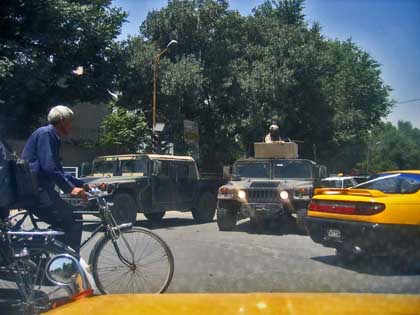
The driver insisted that he gave me a lift. The suggestion that a particular hill not too far away would give me a good view of the city was a good one, and the late evening light was just leaking through the haze. He offered to stay to give me a lift back, but I wanted to be on my own, and writing down that I needed to get back to Choroi Malek Asghar, I wandered off, free at last. Coming down the hill, I wandered through the back streets as I tend to do in cities I am new to. An odd conversation in my broken Urdu helped. As always kids wanted to be photographed, and wherever I went, people offered me cups of tea, or invited me home.
Abdul Karim latched on to me. Insisting that I visit his family, he took me through the narrow winding mud path that led to the tiny doorway that was the entrance to his home. My first task was to take photographs of the family. I had none of the language skills he had, but it didn’t seem to matter. Initially surprised by this stranger the man had brought home, the family quickly turned to more important things, like being hospitable to this mehman (guest).
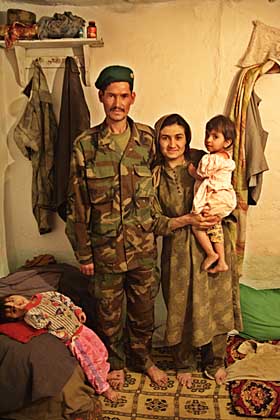
I gesticulated wildly enough to convince them that I needed to catch the light while it was there, and Abdul Karim became my self appointed guide. I could go and take some photographs, but was to come back and have tea. The sun had almost set by the time we were back up the hill. A lone runner ran circles around the flattened top of the hillock. Football fever had set in and the shouting of the kids chasing a ball in the dried up swimming pool in the centre, carried through the evening sky. Four young men came up and made conversation. Two of them had been to Pakistan, and we spoke in Urdu and in English. One was an out of work webmaster, and wanted my email address. They posed, I photographed, and he scribbled his email address so I could email the picture back.
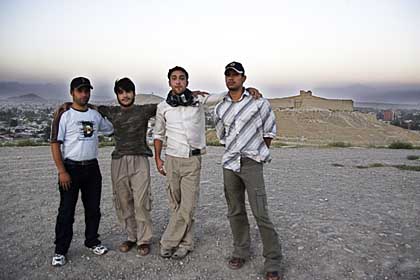
The sun had set and Abdul Karim wanted me to keep my end of the bargain. The young men also wanted me to visit their homes. Perhaps they could take me out the following day they suggested. They knew great places for photography. We exchanged mobile phone numbers. Undiplomatically, I suggested that perhaps they too could come to Abdul Karim?s and then I could go with them to their homes. One young man took me aside and explained that they couldn’t go. It would be breaking purdah. I wondered how I had become an exception to the rule.
Abdul Karim, his mother, Bibi Shirin, his wife Ayesha, and their two children Mehjebeen and Sufia lived in this one room flat. There were mattresses on the floor and one television set and one radio. There was a tiny courtyard and metal steps that went up to what looked like a loft. Abdul Karim had worked as an engineer in the marines and was now out of a job. He showed me the children’s book he used, to try and teach himself English. Even with body language and the best of intentions, our communication faltered, but there was no mistaking that I was a welcome guest, and my major challenge that evening was leaving without having dinner with the family. The path outside was by now pitch black, and Abdul Karim walked me through the maze and got me to a cab. We parted with some sadness.
Back at the Aina office where I was staying, the guard with the Kalashnikov welcomed me with a smile. I could see why my colleague Nazrul hadn’t left the compound for the last two months.
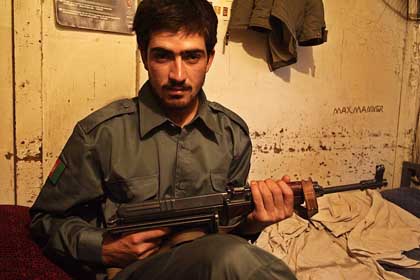
Day before yesterday we drove up to Salang, past the bombed out ruins of what had been thriving villages, past the tank carcasses, past vast stretches of barren land, interspersed with lush foliage by the river beds. A young man took great pleasure in racing his steed against our minivan. Two boys flagged me down, insisting that their friendship be recorded in my camera.
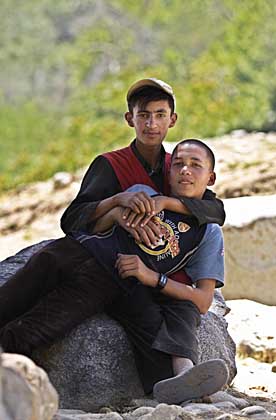
Back in Kabul, I did walk out on my own, without an escort, and went to the marketplace. The men in the bakery insisted that I try their freshly baked bread and I briefly sat with new found friends and watched Hindi films in the restaurants.
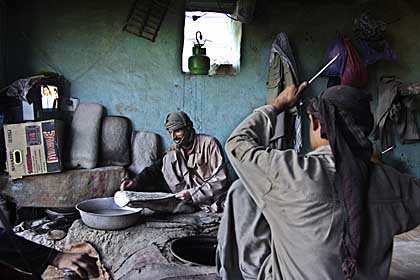
I spoke to Arif who ran a small studio, and came across the out of work labourers in the market square looking for work. A child and an old man reached into the gutter to pick up a polythene bag they could sell. It was in a worker’s face that I realized why people who are capable of so much hospitality, and are so willing to give, have become objects of terror to the foreigners who live here.
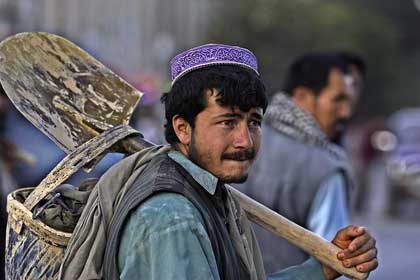
They want the very things that the west has officially championed. Jobs, security, a home for their families and for their land to be free of occupation.
Organisers at the Sarina Hotel claimed it was the first fashion show in 20 years in Afghanistan. There were few tell tale signs of the riots that had taken place here a few days ago. But the white Land Rovers outside, four sets of security barriers, and the armed US soldiers on guard, marked the distance between central Kabul and the rest of the country.
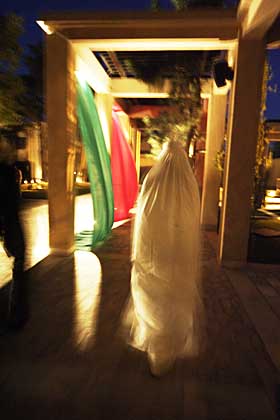
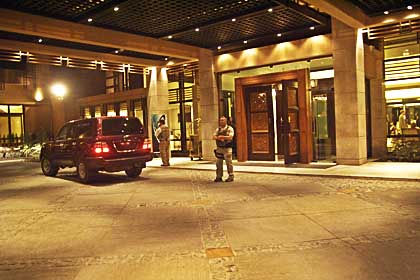
I remember Tolstoy’s words “I sit on a man’s back, choking him, and making him carry me, and yet assure myself and others that I am very sorry for him and wish to ease his lot by any means possible, except getting off his back.” They seem to have learned little in 120 years.
Choroi Malek Asghar
Kabul
9th July 2006
Boundaries
Chobi Mela IV
She packed her load of firewood onto the crowded train in Pangsha. The morning sun peered through the lazy winter haze. The vendors called ?chai garam, boildeem? and the train slowly chugged out of the station, people still clambering on board, or finishing last minute transactions. Some saying farewell. The scene had probably not been very different a hundred years ago. Maybe then, they carried pan in place of firewood, or some other commodity that people at the other end needed. She would come back the same day, bringing back what was needed here. Only today she was a smuggler. The artificial and somewhat random lines drawn by a British lawyer had made her an outlaw. She was crossing boundaries. There were other boundaries to cross. The job a woman was allowed to do, the class signs on the coaches that she could not read but was constantly made aware of. The changing light and the smells as sheet (winter) went into boshonto (spring). The Ashar clouds that the photographers waited for, which seemed to wait until the light was right.
Rickshaw wallas find circuitous routes to take passengers across the VIP road. Their tenuous existence made more difficult by the fact that permits are difficult to get, and the bribes now higher. Hip hop music in trendy discos in Gulshan and Banani with unwritten but clearly defined dress codes make space for the yuppie elite of Dhaka. The Baul Mela in Kushtia draws a somewhat different crowd. Ecstasy and Ganja breaks down some barriers while music creates the bonding. Lalon talks of other boundaries, of body and soul, the bird and the cage.
Photography creates its own compartments. The photojournalist, the fine artist, the well paid celebrity, the bohemian dreamer, the purist, the pragmatist, the classical, the hypermodern, the uncropped image, the setup shot, the Gettys and the Driks. The majority world. The South. The North. The West. The developing world. Red filters, green filters, high pass filters, layers, masks, feathered edges. No photoshop, yes photoshop. Canonites, Nikonites, Leicaphytes, digital, analogue.
The digital divide. The haves, the have nots. Vegetarians, vegans, carnivores. Heterosexuals, metrosexuals, transsexuals, homosexuals. The straight, the kinky. The visionaries, the mercenaries, the crude the erudite, the pensive the flamboyant. Oil, gas, bombs, immigration officials. WTO, subsidies, sperm banks, kings, tyrants, presidents, prime ministers, revolutionaries, terrorists, anarchists, activists, pacifists, the weak, the meek, the strong, the bully. The good the evil. The hawks the doves. The evolutionists, the creationists. The crusaders the Jihadis. The raised fist, the clasped palms. The defiant, the oppressive, the green, the red. The virgin.
Whether cattle are well fed, or children go hungry, whether bombs are valid for defence, or tools of aggression, boundaries ? seen and unseen ? define our modes of conduct, our freedoms, our values, our very ability to recognise the presence of the boundaries that bind us.
Festival Website
